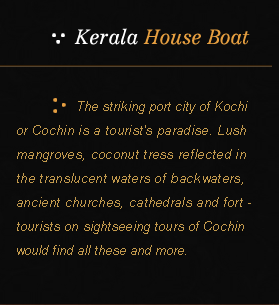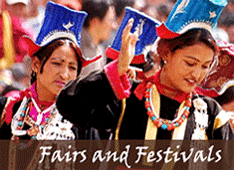Home > North India Tour Packages > Classical India and Nepal Tour

Duration : 19 Days & 18 Nights
Location : Delhi – Jaipur – Agra – Gwalior – Khajuraho – Varanasi – Kathmandu – Pokhra – Kathmandu – Delhi.
Location : Delhi – Jaipur – Agra – Gwalior – Khajuraho – Varanasi – Kathmandu – Pokhra – Kathmandu – Delhi.
Day 01
Delhi Arrival:
COMPANY REPRESENTATIVE will receive you on arrival at the DELHI AIRPORT and transfer to your hotel.
DELHI, the capital of kingdoms and empires is now a sprawling metropolis with a fascinating blend of the past and the present. It is a perfect introduction to the composite culture of an ancient land. A window to the kaleidoscope - that is India.
Overnight will be at Delhi.
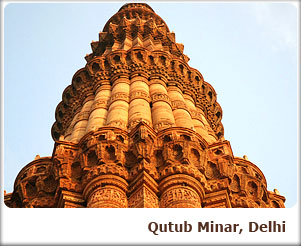 Day 02
Day 02
Delhi:
After breakfast proceed for a day sightseeing tour of the city.
The city is dotted with historic monuments that are the most popular tourist attractions in Delhi. Apart from the monuments, there are museums, markets, gardens and eating joints that you can visit on your tour of Delhi. Some of the important sightseeing places in Delhi are given below.
INDIA GATE: It is the war memorial dedicated to Indian soldiers, who died during World War I. The name of many soldiers who died during World War I is inscribed on its wall. Edward Lutyens, the man who planned and built New Delhi, designed India Gate. Almost every foreign tourist visits the monument. 'Amar Jawan Jyoti', the eternal flame is added later. The eternal flame runs on gas and is a tribute to soldiers who lost their lives in the service of the nation.
RED FORT: Located in Old Delhi, the Red Fort or Lal Quila is a popular tourist attraction in Delhi. The fort was built by the Mughal emperor Shah Jahan in 1648, when he moved his capital from Agra to Delhi. The construction of the Fort started in 1638 and it was completed 10 years later in 1648. Some of the important spots inside the Red Fort include royal baths or Shahi hamams, Shahi Burj, Moti Masjid or the Pearl Mosque, Diwan-e-Aam and Diwan-e-Khas.
JAMA MASJID: The largest mosque in India, the Jama Masjid was built by Shah Jahan 1656 AD. About 5,000 laborers and craftsmen worked for six years to complete the monument. The mosque can accommodate about 25,000 people. The mosque is located in the old Delhi. The domes are built in white marble. The prayer hall of the mosque has 260 pillars.
OLD FORT: Old Fort or Purana Quila as it is called is located near Pragati Maidan on the Mathura Road. You can club a visit to the Old Fort with your tour of Red Fort and Jama Masjid as the three monuments are located in Old Delhi and are not too far from one another. Humanyun’s started the construction of the fort in 1533 AD, but before the completion of the fort, Sher Shah Suri defeated him and captured Delhi. Sher Shah Suri completed the fort and named it -Shergah. He added many structures to the fort, of which Qila-I-Kuhna Mosque and Sher Mandal are worth mentioning. In 1555, Humanyun’s re-captured Delhi and converted Sher Mandal into a library.
HUMANYUN’S TOMB: Humanyun’s Tomb is mausoleum of the Mughal emperor Humanyun’s. Bega Begum also known as Haji Begum, wife of Humayun constructed the mausoleum for her husband. The tomb was built between 1562 and 1572 AD. The tomb was designed by Mirak Mirza Ghiyuth.
QUTAB MINAR: The construction of the Qutab Minar was stated by Qutub-ud-din Aibak in 1199 AD but he died before completing it. His son-in-law and successor Iltutmish completed the construction of the building. Qutab Minar is located in Meharauli.
LOTUS TEMPLE: Also known as the Bahai Temple, the monument was opened to public only in 1986. Located near Nehru Place, the Lotus Temple is designed like a lotus flower. If you are looking for some moments of peace and tranquility in the crowded city, Lotus Temple is the ideal place to visit.
Apart from the above-mentioned sightseeing options, there are various other tourist attractions that you can visit on your tour of Delhi. Some other sightseeing places in Delhi include Lodi Gardens, National Museum, Jantar Mantar, Dilli Haat and the Garden of Five Senses.
Overnight will be at Delhi.
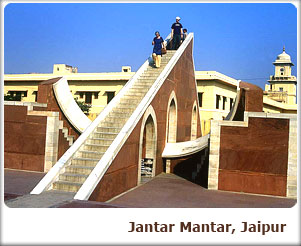 Day 03
Day 03
Delhi – Jaipur:
By Road 260Kms/05hrs
Drive to Jaipur after leisurely breakfast.
Jaipur is the capital of the state of Rajasthan a romantic realm of resplendent palaces, mighty fortresses and regal Maharajahs that lies in the western deserts and is an utterly unique part of India. Proudly belonging to the KSHATRIYA warrior caste and fiercely independent, the Rajput princes made fearsome foes. However, many of them realized that to maintain their wealth and authority locally, it was expedient to proclaim allegiance to the central power. Thus, many enjoyed a privileged position under the Mughal emperors and also the British Raj that followed.
The bustling Rajasthan capital of Jaipur takes its name from its venerated founder Jai Singh II, who was given the title Sawai Maharaja by the Mughal. Literally translated this would mean ’one and a quarter’, suggesting that the Mughal thought this emperor to be more valuable than just ‘one’. Jaipur is known as the ’Pink City’ on account of the distinctive colour of its buildings. This did not, however, form part of the original plan, but dates back to 1856, when the city was given a wash of pink in honor of a State Visit from Prince Albert.
This evening, visit the Birla Temple to learn more about the fascinating religious life of Jaipur. The marble structure, built as recently as 1985, houses ornate statues including one of Lakshmi (goddess of Wealth and Beauty) and Narayan dressed in gaudy robes, representing a Hindu vision of heavenly luxury. Carvings in the temple and on pillars supporting the covered walkways include images of the Hindu pantheon, as well as Jesus, the Blessed Virgin Mary and St Francis of Assisi. Your visit will coincide with the AARTI Ceremony, which involves oil lamps being lit and waved, in order to awake and invoke the deity.
Enjoy the experience and spend night at Jaipur.
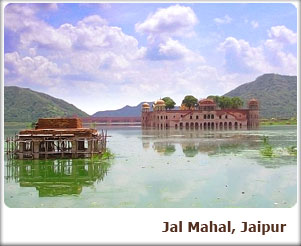 Day 04
Day 04
Jaipur:
After breakfast drive to Amber Palace. Enjoy Elephant Back ascent to the Fort.
AMER PALACE & FORT: Amer Fort and Palace was originally built by Raja Man Singh and subsequently developed by Sawai Jai Singh. The major attractions are Sheela Devi Temple, Sheesh Mahal (Hall of mirrors), Jai Garh Fort a few kilometers from the city centre was built for the defence of the town and has one of the world’s biggest cannons on wheels and a rich collection of arms and weapons.
Continue city sightseeing.
HAWA MAHAL (PALACE OF WINDS): Hawa Mahal is the most strikingly designed monument in Jaipur. Built by the Poet-King Sawai Pratap Singh in 1799, the Hawa Mahal is centrally located and is multiniched five storey high back view of the compled. It was conceived to provide an adequate vantage position behind delicate stone-carved jali, screens for the palace women to watch the royal processions passing through the Bazar below without being seen by outsiders. The Top of the palace affords a beautiful view of the city. A small archaeological museum is yet another attraction in the palace.
JAL MAHAL: The Jal Mahal Palace, Jaipur is noted for its intricate architecture. The Palace was developed as a pleasure spot. It was used for the royal duck shooting parties. On the road to Amber at a distance of 6.5 Kms from Jaipur are the cenotaphs of the royal family. A causeway leads to Jal Mahal Palace situated in the middle of Man Sagar Lake, opposite the cenotaphs. The first four floors of this building is under water, only the top floor remains outside. One can have a wonderful view of the lake and the palace from Nahar Garh Fort Built in 1799, the palace is now abandoned, but reasonably well preserved. In the monsoons, it looks particularly startling with its red sandstone set against the water hyacinth filled lake.
THE CITY PALACE: The city Palace is a historic landmark. The Carved arches are supported by grey-white marble columns studded with floral motifs in gold and colored stones. Two elephants carved in marble, guard the entrance, where retaineers whose families have served generations of the rulers are at hand, to serve as guides.
JANTAR MANTAR Jantar Mantar is one of Sawai Jai Singh’s five remarkable observatories. Constructed with stone and marble its compled instruments, whose setting and shapes are precisely and scientifically designed, represent the high-points of medieval Indian Astronomy. The two Ram Yantras used for gauging altitudes are unique in their isolation. This is the largest of five observatories founded by Sawai Jai Singh-II in various parts of the country.
This evening is free for you to relax shop or explore independently. Shopping is superb in Jaipur, particularly for gold and silver jewellery, pottery, tie-dye materials, silk, saris, wooden handicrafts and carpets.
Overnight will be at Jaipur.
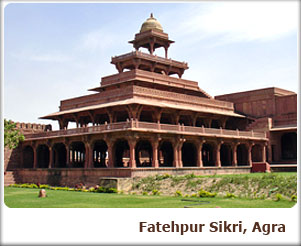 Day 05
Day 05
Jaipur – Fatehpur Sikri - Agra:
By Road 265kms/05hrs
Breakfast will be at hotel.
Drive to Agra visiting Fatehpur Sikri enroute.
FATEHPUR SIKRI – THE CITY OF VICTORY: 37 Kms from the city of Agra, stands Fatehpur Sikri, Akbar’s capital. Full credit goes to the Archeological Survey of India for this perfectly preserved example of a Mughal city at the height of the empire’s splendor. It is an attraction no visitor to Agra should miss. This sprawling structure is made of red sandstone and combines both Hindu and Mughal architecture. This walled city contains the mausoleum of the Sufi fakir, Saleem Chisti who is said to have granted Akbar and his Hindu queen Jodhabai their wish for a son. The main entrance to Fatehpur Sikri is through the 175 feet Buland Darwaza, the highest gateway in the world. It was built by Akbar to commemorate his victory over Khandesh in Gujarat.
The Panch Mahal is a five-storeyed tower, the highest point in Fatehpur Sikri. This extremely airy tower is supposed to have been used by one of the emperor's many queens.
Reach Agra and check into the hotel.
AGRA: Two great Mughal monarchs, Akbar and Shah Jahan, transformed the little village of Agra into a befitting second capital of the Mughal Empire – giving it the name Dar-ul-Khilafat {seat of the Emperor}. Today a visitor to Agra is caught up in a world of contrasting edifices, of red sandstone and white marble, narrow galleys and quaint buggies, and that irresistible charm that this favorite city of the Mughals still retains. It is not surprising, that modern Agra still reflects its Mughal heritage most conspicuously. A walk down the narrow bustling streets of the city will introduce the visitor to the wafting aroma of Mughlai cuisine.
Overnight stay will be at Agra.
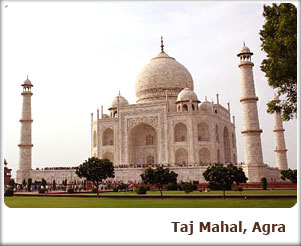 Day 06
Day 06
Agra:
After breakfast proceed for day sightseeing of Agra.
THE TAJ MAHAL – AN EMPEROR’S LAMENT: Agra is the city of the Taj Mahal. It is a sublime experience of the greatest love story ever told. Today India's most fascinating and beautiful masterpiece, this perfectly symmetrical edifice is set amidst landscaped gardens on the banks of the Yamuna River. The Taj was built by the Mughal Emperor Shahjahan as a memorial to his wife, Mumtaz Mahal. After her untimely death, Shah Jahan had her mortal remains buried in this mausoleum. And after his own demise he was placed to rest next to his beloved queen in the same mausoleum. Under the dome, below the ground level, in a dimly lit chamber, lie the mortal remains of Shahjahan and his beloved queen Mumtaz, reminding the world of their undying love. The Taj remains closed for visitors on Friday
AGRA FORT – ARCHITECTURAL WONDER IN STONE: Within a radius of 3 kilometers, on the banks of the river Yamuna raises the crescent like Agra Fort. Designed and built by Akbar in 1565 A.D., the fort is surrounded by a 70 feet high wall. It houses the beautiful Pearl Mosque and numerous palaces including the Jahangir Mahal, Diwan-i-Khas, Diwan-i-Am and Moti Masjid. Later it was used by his son Jahangir also as the seat of power. Shahjahan modeled his creation, the Red Fort at Delhi on this fort. The Agra fort happens to be on the same bank of the river Yamuna as the Taj Mahal which is visible in all its beauty from one side of the fort. So very ironically, Shahjahan, a prisoner of his son Aurangzeb in his old age was put in a cell from where he could gaze at the Taj Mahal at a distance, from his cell in the Agra Fort.
The fort has four gates and is enclosed by a double barricaded wall of red sand stone. Many buildings were constructed within the fort of which very few remain till date. One of the most significant ones is the multi storied Jahangir Mahal built by Akbar for his wife Jodha Bai.
The Mahal is reached through an impressive gateway and its inner courtyard consists of beautiful halls, profuse carvings on stone, exquisitely carved heavy brackets, piers and cross beams.
SIKANDRA: Sikandra, 10 Kms North West of Agra, is the final resting place of Emperor Akbar. The Tomb of Akbar shows an interesting fusion of Hindu and Mughal architecture reflecting the spirit of the Mughal Emperor Akbar. Akbar began the construction of his own garden mausoleum during his lifetime, a red sandstone structure in a char-Bagh meaning 4-square formal garden.
ITMAD – UL – DAULAH’A TOMB: This tomb was erected by Nur Jahan in sweet memory of her father Ghiasud-Din-Beg between 1622 - 1628 A.D. This white marble structure of the pre-Taj era though smaller is often considered equal if not better to the great one itself.
Overnight will be at Agra.
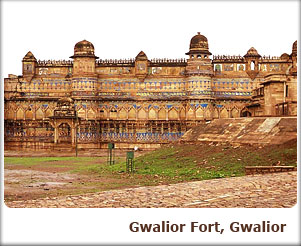 Day 07
Day 07
Agra – Gwalior:
By Road 125Kms/02hrs
Breakfast will be at the hotel.
Proceed to Gwalior. Reach and check into the hotel.
Located at a strategic site, in the Grid region of Northern India, Gwalior is a celebrated city of Madhya Pradesh. With its white sandstone mosques, studded temples and soaring buttresses, the place recounts the majesty of the Indian soil. A chronicler of the rise and fall of many dynasties, the place still retains its antique vaudeville in its art and architecture. Tourists from all over the world trot to the place to get a glimpse of its fine enmeshing of antiquity and modernity. Boasting of a rich historical saga, Gwalior is one of the most prominent tourist destinations in Central India. This article will help you explore the various places of tourist interest to be seen in Gwalior.
Overnight will be at Gwalior.
Day 08
Gwalior:
Proceed for a sightseeing tour of the city visiting the following interesting monuments after leisurely breakfast.
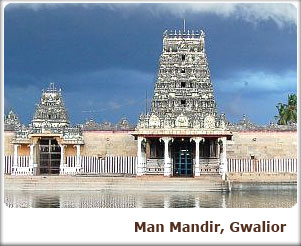 Gwalior Fort: Positioned at a height of 100m above the main town of Gwalior, this staggering citadel dominates the skyline of the place and is acknowledged as the most impregnable fort in the whole of Central and Northern India. Built by Raja Man Singh Tomar, in the 15th century, its beauty has earned it the epithet of "The Pearl amongst Fortresses of India" by the Mughal ruler 'Babur'. The fort is girdled by sandstone walls and stretches over an area of 3 sq km. It houses three temples, six palaces and a large number of water tanks.
Gwalior Fort: Positioned at a height of 100m above the main town of Gwalior, this staggering citadel dominates the skyline of the place and is acknowledged as the most impregnable fort in the whole of Central and Northern India. Built by Raja Man Singh Tomar, in the 15th century, its beauty has earned it the epithet of "The Pearl amongst Fortresses of India" by the Mughal ruler 'Babur'. The fort is girdled by sandstone walls and stretches over an area of 3 sq km. It houses three temples, six palaces and a large number of water tanks.
Man Mandir: This exquisite architectural specimen was also built by Raja Man Singh Tomar, between 1486 and 1517. Though, most of the ornamentations of this mammoth edifice have been corroded with time, traces of elaborate architectural trimmings and patterns still testify its glorious past. With decorative and colorful friezes and ornate rooms and stone screens, it exhibits a tasteful use of color, motif and patterns. The place houses the 'Suraj Kund Pond', where King Suraj Sen is believed to have been cured by sage Gwalipa.
Teli-ka-Mandir: This ancient edifice is a Pratihara Vishnu temple. Built in the 9th century AD, it towers at a height of 100ft. According to legends, the temple is so named as it is believed to be fabricated in the 'Telangana' architectural style. However, others believe that it is named after the 'Telis' (oil merchants) who built it. The structure displays a unique architectural pattern, with fine blend of Dravidian and Indo-Aryan characteristics. The roof of the temple is distinctly Dravidian, whereas the festoons and adornments have a strong Indo-Aryan appeal.
Saas-Bahu Temple; The Saas-Bahu temple dedicated to Lord Vishnu is also a major landmark of Gwalior. Built in 11th century, the name of the temple can be quite misleading. The temple, as many people believe, is not dedicated to 'Saas' (mother-in-law) and 'Bahu' (daughter-in-law). The name metaphorically and traditionally implies to two temples of different sizes adjoined to each other. The larger is more elaborately patterned with intricate artwork and attractive sculptures. There is also an ornamental lotus adorning its interior roof.
Jai Vilas Palace: Though Jai Vilas Palace is the current residence of the Scindia family; 35 of its palatial rooms have been converted into the 'Scindia Museum'. The architectural style of this imperial structure is dominantly Italian, with a fine blend of Corinthian and Tuscan architectural modes. Handpicked royal treasures and historical artifacts from different countries are displayed in the museum. The most striking one is a silver train, with cut-glass wagons and miniature rails, which chugged along dinner tables and was used to serve food to the guests.
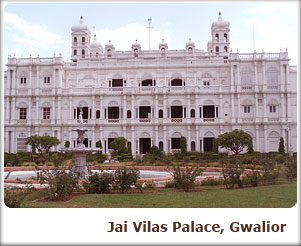 Tomb of Tansen: The father of Hindustani classical music and one of the nine jewels of Akbar's court, legendary singer Tansen is buried in Gwalior. Built in the early style of Mughal architecture, the tomb of Tansen has a simple and pristine aura about it. The headstone is surrounded by beautiful gardens on all its sides. Apart from being an ancient monument, the site also underlines the rich cultural heritage of Gwalior. Every year in the month of November/ December, a national level music competition is held at the place, to venerate this great musician.
Tomb of Tansen: The father of Hindustani classical music and one of the nine jewels of Akbar's court, legendary singer Tansen is buried in Gwalior. Built in the early style of Mughal architecture, the tomb of Tansen has a simple and pristine aura about it. The headstone is surrounded by beautiful gardens on all its sides. Apart from being an ancient monument, the site also underlines the rich cultural heritage of Gwalior. Every year in the month of November/ December, a national level music competition is held at the place, to venerate this great musician.
Mausoleum of Ghaus Mohammed; Located in the old town of Hazira is the mausoleum of Ghaus Mohammed, the 'Afghan Prince turned Sufi Saint' who helped Babur in annexing the Gwalior Fort. Built in the 16th century, this sandstone tomb is an exemplary piece of Mughal architectural adroitness. Built opulently in early Mughal lines, the screens of the monument have been carved using the pierced stone technique. Thus, these fine trellises look like delicate and exquisitely patterned laces. The beauty of the monument is also enhanced by the dappling gardens that surround it.
Overnight will be at Gwalior.
Day 09
Gwalior – Jhansi:
By Train
Train Name : Bhopal Shatabdi
Train No. : 2002
Departure : 0934 hr
Arrival : 1043 hr
Jhansi – Orchha - Khajuraho:
By Road 175Kms/04hrs
Early morning you will be transferred to the railway station to board train for Jhansi. Reach Jhansi and drive to Khajuraho visiting Orchha enroute.
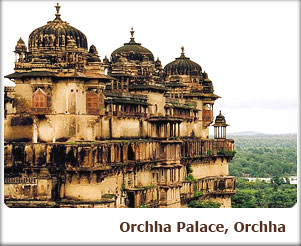 ORCHHA - The grandeur and opulence of the former Bundela dynasty is well reflected in Orchha set amidst the flat Bundelkhand countryside. Built by Raja Rudra Pratap on an artificial island on Betwa river, Orchha (17 Km from Jhansi) takes you back to a royal era when Bundela rulers enjoyed the finer things of life cocooned in the comforts of their citadel. Orchha is a photographer's delight. With its forts, regal palaces, striking temples and chattris, it narrates a beautiful medieval tale.
ORCHHA - The grandeur and opulence of the former Bundela dynasty is well reflected in Orchha set amidst the flat Bundelkhand countryside. Built by Raja Rudra Pratap on an artificial island on Betwa river, Orchha (17 Km from Jhansi) takes you back to a royal era when Bundela rulers enjoyed the finer things of life cocooned in the comforts of their citadel. Orchha is a photographer's delight. With its forts, regal palaces, striking temples and chattris, it narrates a beautiful medieval tale.
Continue drive to Khajuraho. Reach and check into the hotel.
Khajuraho, which has lent its name to a complex of exquisite Hindu and Jain temples, is a small town located amidst the forested plains of Bundelkhand in north-central Madhya Pradesh. The beautiful temples that dot Khajuraho are believed to have been built by the mighty Chandela rulers in the 9th and 10th century AD. The engravings on these temples are highly sensual and erotic that depicts in graceful forms intimate scenes of the whole range of human emotions and relationships. These sculptures congeal in stone a lyrical paean to love and passion and reflect the Chandela dynasty/’s immense appreciation for art.
Architecturally, the temples are built in the north Indian Nagara style. The sculptor/’s fine skill and a sense of imagination have given form to human emotion in the form of spiritual and physical love. Every façade—wall, window, pillar, and ceiling—is carved with figures of mythical and historical origins, and while many of these depict full-breasted, girdle-waisted women in forms of innocent play, they also depict carnal love.
Khajuraho combines history, architecture, culture and environment with delectable charm. It is a town that takes you away from the noise and pollution of the city, with its fresh air and scenic countryside. For convenience, the temples of Khajuraho are divided into the Western, Eastern, and Southern groups. The Western Group, situated opposite the Government of India Tourist Office, has 14 temples. The Chaunsath Yogini, Lalguan Mahadev, Parvati, Varaha, Matangesvara, Lakshmana, Vishvanath and Nandi, Chitragupta, Devi Jagdamba and Kandariya Mahadeo temples belong to this group. The Eastern Group, 2.4 km from the Tourist Office, consists of seven temples (four Jain and three Hindu). The Parsvanath, Adinath, Shantinath, and Ghantai temples belong to the Jains while the Vamana, Javari and Brahma are Hindu temples. The Southern Group, about 5 km from Khajuraho, contains the Chaturbhuj and Duladeo temples.
Enjoy the Light and Sound show in the evening.
Overnight will be at Khajuraho.
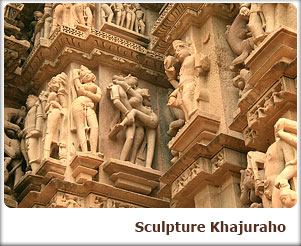 Day 10
Day 10
Khajuraho:
After breakfast proceed for a tour of the FAMOUS WESTERN & EASTERN TEMPLES of Khajuraho.
The Western group of temples: Primarily built in one style the temples have the ardhamandapa or the entrance, the mandapa or the assembly hall, the antarala or the vestibule and finally a pradakshina or a circumambulation running around the grabha griha or the inner sanctum. The temples are divided in three major zones, the western, the eastern and the southern temples of which the western temples are the most popular ones.
The arch of Kandariya Mahadev shrine has meticulously carved various themes of life. Celestial beings, lovers serenading musicians all the movements captured in stone, frozen in time, yet retaining a quality of warm, pulsating life. The very stone seems to have taken on the living, breathing quality of the carved figures. outer walls have three horizontal panels showing deities of the Hindu pantheon, and groups of lovers, a pageant of sensuousness, vibrantly alive. The Chousat Yogini temple dedicated to kali is also present but without the deity in the sanctum. The Matangeshwara temple is the only shrine used for worshipping. The temple is almost devoid of ornamentation. The Varaha Temple stands opposite the Matangeshwara temple and is dedicated to the fourth incarnation of Lord Vishnu in form of a Boar. The monolithic figure is exquisitely carved with 764 divine figures around it. The Lakshmana Temple, dedicated to the four armed and three headed man-lion-boar statue of Vaikuntha, is the best preserved and the most evolved Vishnu temples. There are sculptures depicting many mythological stories such as the churning of the ocean and Kalia mardan. O n the exterior the entire range of the Khajuraho temples is on display. Ecstatic street singers and the architect of the temples, surrounded by his apprentices are among the noteworthy images on this temple. The Vishwanath temple was supposed to be embedded with jewels, but only a stone lingam is what remains now. The exteriors of this temple however are the most stunningly beautiful. Here one can see nymphs can be seen playing on their flutes, removing thorns from their feet, fondling children and looking into a mirror. Some of the most erotic depictions are seen as well. Another interesting temple is dedicated to the Sun God, the Chitragupta temple. It shows the Sun God driving the chariot drawn by seven horses. The exteriors show, royal processions, elephant-fights, hunting scenes, group dances and the lavish lifestyle of the Chandela kings and their court in its all pomp and glory
The Eastern Group of temples: The Brahma and the Hanuman temples are the most famous and well preserved temples of this group. The Vamana temple shows all the ten incarnations of Lord Vishnu.
This place also has a few temples belonging to the Jain religion, probably because one of the descendants of the Chandela dynasty may have adopted Jainism. The prominent among these are the Ghantai temple, the Parsvanath and the Shnatinath temple.
Overnight will be at Khajuraho.
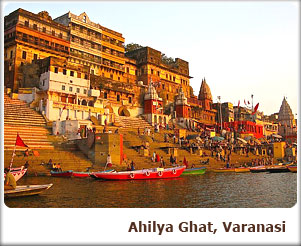 Day 11
Day 11
Khajuraho – Varanasi:
By Air
Breakfast will be at the hotel.
Transfer to the airport to take flight for Varanasi. Reach and check into the hotel.
Varanasi is the World's most ancient living city. Crowded with temples, and its labyrinth of Varanasi, the cultural capital of India, has many shades. Nowhere in the world have you found such vivid hues amalgamating at a single place. The city has everything that a disturbed soul seeks and much more. Marked by it numerous temples and 80 Ghats, Varanasi is humanism personified. A tour to this city is a must for every visitor who ventures to India. The city has various temples and attractions to offer to visitors.
Enjoy the evening AARTI at the GHATS. The guide will be giving a commentary to you on the proceedings and meanings of the chants during the AARTI of the river.
Overnight will be spent at Varanasi.
Day 12
Varanasi:
Proceed in the morning to Daswamedh Ghat and take a boat ride on the sacred river Ganges to see the cremation Ghats and witness the living traditions of one of the world's oldest and most important religions.
Cruise the Ganges. Perhaps the best way to enjoy the site of Varanasi’s Ghats is a cruise along the river at dawn. Hundreds of bathers, worshippers performing religious rites, holy men practicing yoga and people washing clothes gather at the river’s banks. (To start at 0500 hrs. for the best lifetime experience) For you to appreciate this remarkable city, we’ll transfer you to the banks of the River Ganges before the sun rises. Board a boat with your guide and proceed to the middle of the river, where at sunrise the sight unfolds before you. Thousands of faithful come daily to the banks to bathe and pray while in the background, temples and palaces rise in tiers from the water’s edge. Return for a walk through the cobblestone streets along the banks of "Ganga". As shops are opening, the place now becomes a beehive of activity as the faithful are coming and going.
Return to hotel for a sumptuous breakfast.
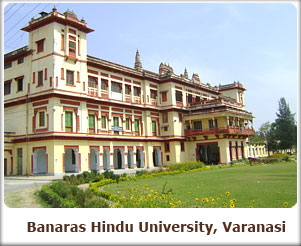 Proceed for the sightseeing.
Proceed for the sightseeing.
Bharat Mata Mandir: Bharat Mata Mandir or Bharat Mata Temple is one of its kinds in Varanasi. Contrary to what most of the tourists believe, this temple is not dedicated to any God, Goddess or certain deity for that matter. It is dedicated to the human manifestation of India popularly called Mother India or Bharat Mata in Hindi. The temple was inaugurated by non other than Mahatma Gandhi, The father of the Indian Nation.
Banaras Hindu University: BHU was built in the year 1916-1917 under the special act of parliament passed in the year 1915 named BHU act. The act was passed by the interim parliament that worked under the imperial British government. Mahamna Pundit Madan Mohan Malaviya and Annie Besant did the conceptualization and implementation of this university. Raja of Kashi donated 1350 acres of land for the construction of the sprawling campus.
Durga Mandir: Goddess Durga is a significant manifestation of Parvati, the consort of Lord Shiva. In fact she is said to be Shakti, or the manifestation of Parvati that signifies the female element of Power and harmony in nature. This is precisely because a Bengali Maharani built this temple in the 18th century.
Kashi Vishwanath Mandir: The Vishwanath temple is synonymous to Varanasi. Vishwanath Temple is the most sacred and the most famous temple in Varanasi. In fact, Vishwanath Temple is extremely popular in other parts of India too. A considerable chunk of foreign visitors in India come to Varanasi every year to get a glimpse of the Vishwanath Temple even though the followers of Semitic religions are not allowed to enter the sanctum of the temple.
Tulsi Manas Mandir: Tulsi Manas Temple has a very historical as well as cultural importance for not only Varanasi but also for the whole of India. This is because Ramayana was composed at this very place. Goswami Tulsi Das was the man who composed Ramayana in Hindi in the form of "Ram Charit Manas".
Visit Sarnath ‑ 5 miles out of Varanasi: The great Buddha enhanced the sanctity of Varanasi by choosing the environs of the city to preach his first sermon at Sarnath, (only 10 Kms away) after attaining enlightenment. Later, Ashoka, the great Mauryan Emperor erected magnificent stupas and other buildings along with his mighty stone pillar, Dharmarajika Stupa. The 110 ft. tall Damekh Stupa marks the place where Buddha preached first sermon. Sarnath has been a premier centre for Buddhism. It is a rich collection of ancient Buddhist relics and antiques comprising numerous Buddha and Bodhisatva images on display at the Archaeological Museum (1000 hrs to 1700 hrs. Open all days except Friday)
Overnight will be in Varanasi.
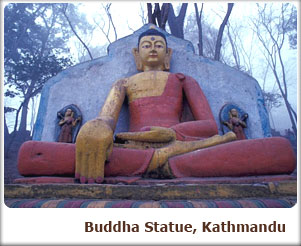 Day 13
Day 13
Varanasi – Kathmandu:
By Air
Breakfast will be at the hotel.
Transfer to the airport to take flight for Kathmandu. Reach and check into the hotel.
It is said that king Gun Kamdev founded Kathmandu in the year 723 AD. If you go by the legend, the area was a lake in the past. A Buddhist deity named Manjushri liked the place and wanted habitation there. The Buddhist god then bifurcated the hill to the south and allowed the water to flow out. As the water flowed out, the region became habitable. Of course, this is a Buddhist tradition and is different from the one by Hindus. The origin of the name is still unclear and historians spin new theories every other day according to their whim and fancies. Nevertheless one of the more likely theories is that it was named after Kastha-Mandap ("temple of wood" in Sanskrit). King Laxmi Narashingha Malla commissioned a pagoda carved from the single tree in 1596 and it might be possible that the same pagoda is behind its naming.
Kathmandu is the Mecca of Nepal's traditional culture, arts and cuisines. This is the place for rest and relaxation and don't have hectic lifestyle that has so become part and parcel of metropolitans round the world. The easy-day sightseeing takes you to various historic and artistic temples and monuments. One also enjoys Kathmandu for nightlife, shopping and for the mountain views. The place is famous for handicrafts items that can be bought for mementos and gifts. The embroidered clothes are the other must buy items.
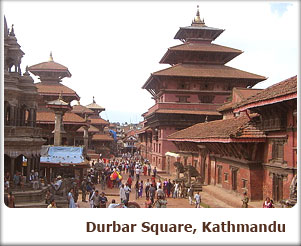 THE DURBAR SQUARE is same to Nepal as Tianmen Square is to Beijing. The place has been listed in the UNESCO world heritage site. Durbar Square is the focal point of religious and social activities in Kathmandu Old City. This place comprises palaces, temples, shrines, statues and courtyards built between the 12th and 18th centuries by the ancient kings of Nepal. The Durbar square is the subtle amalgamation of old and new. The elaborately carved architectural features and curving roofs are night stays for beggars and tourists. Priests and monks who jostle along the crowd to attract a possible client accompany them.
THE DURBAR SQUARE is same to Nepal as Tianmen Square is to Beijing. The place has been listed in the UNESCO world heritage site. Durbar Square is the focal point of religious and social activities in Kathmandu Old City. This place comprises palaces, temples, shrines, statues and courtyards built between the 12th and 18th centuries by the ancient kings of Nepal. The Durbar square is the subtle amalgamation of old and new. The elaborately carved architectural features and curving roofs are night stays for beggars and tourists. Priests and monks who jostle along the crowd to attract a possible client accompany them.
Two ferocious looking stone lions guard the gates of Old Royal Palace that was abandoned by the monarchs in the late 18th century. The campus contains a number of courtyards and several museums. There is a plaque that is set in the palace walls which is said to be 400 years old. The inscriptions written on the plaque is in 15 different languages. On the other side of the square is the Kastha Mandap temple that is said to have bore its name to Kathmandu. The unique feature of this temple is that it has been constructed of wood out of a single tree. The structure is an open pavilion that is topped by a pyramidal tower. It is purportedly the Valley's oldest building.
Kathmandu Durbar square, also known as Hanuman Dhoka Durbar, used to be the residence of the Nepali royal family and administrators. The palace became a public attraction when the monarchs shifted to the newly build Narayanhity Palace. The Hanuman Dhoka Durbar lies in the heart of the city. It consists of huge Royal Palace with different temples dating from the 15th to the 18th century. This palace is named after Hanuman, a Hindu deity and a stone statue of Hanuman is placed right next to the main entrance.
In the evening enjoy a local dance program with an authentic NEPALI DINNER at the cultural centre.
Overnight will be at Kathmandu.
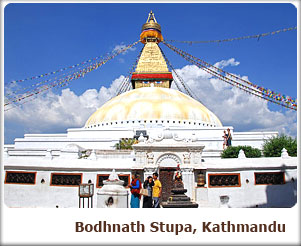 Day 14
Day 14
Kathmandu:
Breakfast will be at hotel.
OPTIONAL: Take an early morning EVEREST FLIGHT for a view of the majestic HIMALAYAS and the MOUNT EVEREST.
Proceed for visits to PASUPATINATH, SWAMBHUNATH & BOUDHNATH.
PASHUPATINATH is not only the holiest Hindu pilgrimage in Nepal but also one of the holiest destinations in the entire world. This temple that has been declared UNESCO Heritage site has been erected and razed to the ground numerous times. There are lingam images of Shiva along with statues and temples dedicated to other deities in the complex. There is historical evidence that a temple dedicated to Shiva existed at this site in AD 879. What happened of that temple, nobody knows. However, King Bhupatindra Malla built the present temple in the year 1697. The present temple is the subtle work of architecture with its gold-plated roof, be-jeweled doors, flowered motifs and woodcarvings of the finest quality. The square-shaped pagoda like temple, which is built on a single platform of 24 meters in height, stands in the middle of an open courtyard. The entrance of the temple is from all the four sides and is decorated by gold-gilt doors. Inside the temple there is a narrow walk engulfing the sanctum from where one can have closer view of Shivlinga.
Pashupatinath area is regarded as one of the most important places of pilgrimages for the followers of Hinduism in the entire world. Thousands of devotees come to pay homage to Pashupatinath every day. On special occasions like Ekadasi, Sankranti, Maha Shivaratri, Teej Akshaya, Rakhi, Grahana (eclipse), Poornima (Full moon day) people congregate here in far greater number.
The Buddhist temple of SWAYAMBHUNATH, situated on the top of a hill, west of Kathmandu, is one of the most popular, holy and instantly recognizable symbols of Nepal. The temple is colloquially known as the 'monkey temple' because of the large tribe of roving monkeys who guard the temple.
Swayambhunath Stupa is a golden spire crowning a conical wooded hill. It is the most ancient and enigmatic of all the holy shrines in Kathmandu Valley. It has a lofty white dome and a glittering golden spire that are visible from all sides of the valley. Historical records found on a stone inscription give evidence that the stupa was already an important Buddhist pilgrimage destination by the 5th century A.D. i.e. before the coming of Buddhism in the valley.
BOUDDHNATH STUPA is not only the largest Stupa in Nepal but also one of the largest Stupas in entire Asia. Since ages Bouddhnath has been a citadel and center of attraction of Tibetan Lama Buddhism in Nepal. This white pagoda that stands 36 meters on its feet falls in the way of the ancient trade route between Bihar and Tibet and that is why it was the focal point for the caravans that passed either ways. Tibetan merchants and hermits have rested and offered prayers here for many centuries. Travelers like Fa'Hein have traversed the same route.
The area around the Bouddhnath Stupa is a feast to the eyes typical to all Tibetan Buddhist sites. Colorful Thangkas and flags mark the whole area. It is also a shopper's paradise in Kathmandu. Tibetan jewelry, hand-woven carpets, masks, and Khukri knives are some of the must buy items in this market.
Smaller Stupas are located at the base. Gompa monasteries, curio shops, and restaurants surround Bouddhanath. Conveniently situated restaurants with rooftop patios provide good food and excellent views of Bouddhanath.
Overnight will be at Kathmandu.
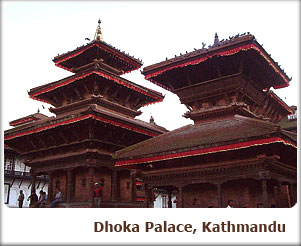 Day 15
Day 15
Kathmandu:
Breakfast will be at the hotel.
Proceed for a full day visit of PATAN & BHAKTAPUR.
PATAN is protected by UNISCO world heritage site. Patan is the second largest city in the valley. It is some time referred to as Lalitpur, which means city of beauty. Patan has long Buddhist history and the four corners of the city are marked by stupas. Patan’s central Durbar square is absolutely packed with temples. It an architectural feast with a far greater concentration of temples per sq meter than in Kathmandu or Bhaktipur. Numerous other temples widely diverse style as well as many Buddhist monasteries are scattered around this fascinating town. The Patan Durbar square is a concentrated mass of temples, undoubtedly the most visually stunning display of Newari architecture to be seen in Nepal. There is also many others numerous temples are Krishna, Bhimsen, Taleju bell, Bhai Dega and others many temples gives you more experience about Nepali people faith and respect on religion. All the temples are decorated by numerous arts and architecture. The Patan also offers you Newari people culture and them life style.
The ancient city is located on the southern bank of the holy Bagmati River and is approximately five kilometers south-east of the capital. The whole city is full of Buddhist monuments and Hindu temples with fine bronze gateways, marvelous statues, guardian deities and magnificent carvings including stone carving, metal carving and wood carving. Well noted for its gorgeous craftsmen and metal workers, it is often known as the city of superb artists. The majority of the citizens follow the Buddhist faith.
Located about 20 km east of Kathmandu in the Kathmandu Valley, BHAKTAPUR is known as the 'City of Devotees', the 'City of Culture', the 'Living Heritage', and 'Nepal's Cultural Gem'. It is one of the 3 royal cities in the Kathmandu Valley. The others are Kathmandu, the capital of Nepal, and Patan.
Bhaktapur is filled with monuments, most terra-cotta with carved wood columns, palaces and temples with elaborate carvings, gilded roofs, and open courtyards. The city is dotted with pagodas and religious shrines.
Lying along the ancient trade route between India and Tibet, Bhaktapur is surrounded by mountains and provides a magnificent view of the Himalayas.
Overnight will be at Kathmandu.
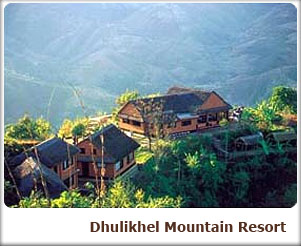 Day 16
Day 16
Kathmandu – Excursion to Dhulikhel:
Enjoy breakfast in the hotel.
Drive to Dhulikhel. Situated at about 30 miles covered in 45 minute drive, to the east of Kathmandu, lies the small town of Dhulikhel. Nestled in the laps of Himalayas, the place offers a breathtaking view of the northeastern part of the mountains. Dhulikhel is located at the foothills of the Panchkhal Valley, which is about 21 miles to the east of Kathmandu on a Chinese built Arniko highway, which leads to Tibet, crossing at Kodari.
Overnight will be at Kathmandu.
Day 17
Kathmandu – Pokhara:
By Local Flight
Breakfast will be at the hotel.
Take local flight for Pokhara. Reach and check into the hotel.
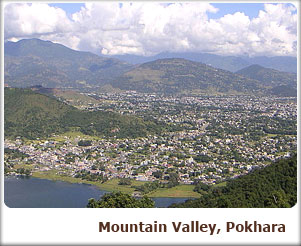 Pokhara is situated at about 827 meter from sea level. The magnificent city is located about 200 kilometers west of Kathmandu and can be reached both by aircraft as well as bus. The journey duration is 35 minutes and 5 hours respectively. As far as adventure trips are concerned, Pokhara is the next destination after Kathmandu. Pokhara is often called the enchanting Himalayan valley with a heart of major actions and adventures.
Pokhara is situated at about 827 meter from sea level. The magnificent city is located about 200 kilometers west of Kathmandu and can be reached both by aircraft as well as bus. The journey duration is 35 minutes and 5 hours respectively. As far as adventure trips are concerned, Pokhara is the next destination after Kathmandu. Pokhara is often called the enchanting Himalayan valley with a heart of major actions and adventures.
Surrounded by beautiful snow-capped mountains with a magnificent lake of crystal-clear pure Himalayan water; the Pokhra is a dream come true. An all-year round pleasing weather and friendly inhabitants will greet you with smile and leave you with the most unforgettable moments in your life. So pack up your bag, load your camera, and get ready for Pokhara experience!
Among the attractions, nothing is as majestic as the Fewa (or Phewa) Lake. The lake is 1.5-kilometer long and second largest in Nepal. Fewa Lake offers an excellent view of the mountains and their reflections in the water. This picturesque place is a hot favorite among the honeymoon couple. There are as many as 8 different lakes in Pokhra and apart from Fewa Lake, Begnas and Rupa Lakes are the most serene. Both these lakes are located about 15 km from Pokhara and are ideal places for relaxation, boating and fishing.
Another spectacular sight in Pokhara is the sight of Annapurna range. This magnificent range stretching from west to east looks beautiful in the glittering sunlight. Apart from that Seti Gandaki and Seti Gorge are other two important places to visit in Pokhara. The Seti Gandaki flows right through the city at places it runs completely underground. The best view of the river can be seen from the top of the Seti Gorge. Then you have Mahendra cave that is located about 10km north from downtown Pokhara. It is a natural site located across the Seti River.
Pokhara is also known for its Newari and Tibetan artifacts. No trip to Pokhara can be complete without buying Newari handicrafts items. Don't forget to buy Tibetan carpet as well. The Newars have heavily contributed to the culture of Pokhra and that can be witnessed in its magnificent cuisines. Newari food is a must eat in Pokhra.
Overnight will be at Pokhra.
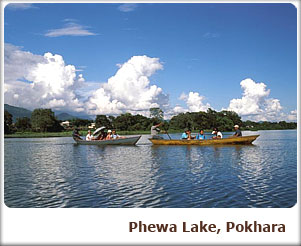 Day 18
Day 18
Pokhara:
We start our day with the early morning visit to Sarangkot for the fabulous sunrise. After the spectacular sunrise, we drive back to our hotel to start our remaining activities for the day with the breakfast at the hotel.
Today, we take you to the famous Devi’s Fall (also known as Devin’s or David’s) locally known as Patale Chhango (Hell’s Fall), an awesome waterfall lying about 2 km south-west of Pokhra Airport on the highway to Tansen. Legend has it that a trekker (Devin, David…) was washed away by the Pardi Khola and mysteriously disappeared down into an underground passage beneath the fall.
Bindhyabasubu Temple at the old bazaar, Seti Gandaki, the boisterous river running completely underground at the places, Mahendra cave (House of Bats), the natures’ wonder at Pokhra & Pokhra Museum.
After lunch, start exploring the city by driving to the Begnas Lake & Rupa Lake located 15 Km from Pokhra divided by a forested hillock called Panchabhaiya Danda, offering the perfect nature retreat with their relative seclusion.
Overnight will be at Pokhra.
Day 19
Pokhara – Kathmandu:
By Local Flight
Kathmandu – Delhi - Departure:
By Air
Enjoy breakfast in the hotel.
Proceed to Kathmandu. Reach and take connecting flight for Delhi.
Reach Delhi and enjoy last minute shopping.
As per your INTERNATIONAL FLIGHT TIMINGS you’ll be transferred to the airport to take your flight back home with sweet memories of FASCINATING NORTH INDIA & NEPAL TOUR
...........................................................................TOUR ENDS...........................................................................
INCLUSIONS:
Delhi Arrival:
COMPANY REPRESENTATIVE will receive you on arrival at the DELHI AIRPORT and transfer to your hotel.
DELHI, the capital of kingdoms and empires is now a sprawling metropolis with a fascinating blend of the past and the present. It is a perfect introduction to the composite culture of an ancient land. A window to the kaleidoscope - that is India.
Overnight will be at Delhi.
 Day 02
Day 02 Delhi:
After breakfast proceed for a day sightseeing tour of the city.
The city is dotted with historic monuments that are the most popular tourist attractions in Delhi. Apart from the monuments, there are museums, markets, gardens and eating joints that you can visit on your tour of Delhi. Some of the important sightseeing places in Delhi are given below.
INDIA GATE: It is the war memorial dedicated to Indian soldiers, who died during World War I. The name of many soldiers who died during World War I is inscribed on its wall. Edward Lutyens, the man who planned and built New Delhi, designed India Gate. Almost every foreign tourist visits the monument. 'Amar Jawan Jyoti', the eternal flame is added later. The eternal flame runs on gas and is a tribute to soldiers who lost their lives in the service of the nation.
RED FORT: Located in Old Delhi, the Red Fort or Lal Quila is a popular tourist attraction in Delhi. The fort was built by the Mughal emperor Shah Jahan in 1648, when he moved his capital from Agra to Delhi. The construction of the Fort started in 1638 and it was completed 10 years later in 1648. Some of the important spots inside the Red Fort include royal baths or Shahi hamams, Shahi Burj, Moti Masjid or the Pearl Mosque, Diwan-e-Aam and Diwan-e-Khas.
JAMA MASJID: The largest mosque in India, the Jama Masjid was built by Shah Jahan 1656 AD. About 5,000 laborers and craftsmen worked for six years to complete the monument. The mosque can accommodate about 25,000 people. The mosque is located in the old Delhi. The domes are built in white marble. The prayer hall of the mosque has 260 pillars.
OLD FORT: Old Fort or Purana Quila as it is called is located near Pragati Maidan on the Mathura Road. You can club a visit to the Old Fort with your tour of Red Fort and Jama Masjid as the three monuments are located in Old Delhi and are not too far from one another. Humanyun’s started the construction of the fort in 1533 AD, but before the completion of the fort, Sher Shah Suri defeated him and captured Delhi. Sher Shah Suri completed the fort and named it -Shergah. He added many structures to the fort, of which Qila-I-Kuhna Mosque and Sher Mandal are worth mentioning. In 1555, Humanyun’s re-captured Delhi and converted Sher Mandal into a library.
HUMANYUN’S TOMB: Humanyun’s Tomb is mausoleum of the Mughal emperor Humanyun’s. Bega Begum also known as Haji Begum, wife of Humayun constructed the mausoleum for her husband. The tomb was built between 1562 and 1572 AD. The tomb was designed by Mirak Mirza Ghiyuth.
QUTAB MINAR: The construction of the Qutab Minar was stated by Qutub-ud-din Aibak in 1199 AD but he died before completing it. His son-in-law and successor Iltutmish completed the construction of the building. Qutab Minar is located in Meharauli.
LOTUS TEMPLE: Also known as the Bahai Temple, the monument was opened to public only in 1986. Located near Nehru Place, the Lotus Temple is designed like a lotus flower. If you are looking for some moments of peace and tranquility in the crowded city, Lotus Temple is the ideal place to visit.
Apart from the above-mentioned sightseeing options, there are various other tourist attractions that you can visit on your tour of Delhi. Some other sightseeing places in Delhi include Lodi Gardens, National Museum, Jantar Mantar, Dilli Haat and the Garden of Five Senses.
Overnight will be at Delhi.
 Day 03
Day 03 Delhi – Jaipur:
By Road 260Kms/05hrs
Drive to Jaipur after leisurely breakfast.
Jaipur is the capital of the state of Rajasthan a romantic realm of resplendent palaces, mighty fortresses and regal Maharajahs that lies in the western deserts and is an utterly unique part of India. Proudly belonging to the KSHATRIYA warrior caste and fiercely independent, the Rajput princes made fearsome foes. However, many of them realized that to maintain their wealth and authority locally, it was expedient to proclaim allegiance to the central power. Thus, many enjoyed a privileged position under the Mughal emperors and also the British Raj that followed.
The bustling Rajasthan capital of Jaipur takes its name from its venerated founder Jai Singh II, who was given the title Sawai Maharaja by the Mughal. Literally translated this would mean ’one and a quarter’, suggesting that the Mughal thought this emperor to be more valuable than just ‘one’. Jaipur is known as the ’Pink City’ on account of the distinctive colour of its buildings. This did not, however, form part of the original plan, but dates back to 1856, when the city was given a wash of pink in honor of a State Visit from Prince Albert.
This evening, visit the Birla Temple to learn more about the fascinating religious life of Jaipur. The marble structure, built as recently as 1985, houses ornate statues including one of Lakshmi (goddess of Wealth and Beauty) and Narayan dressed in gaudy robes, representing a Hindu vision of heavenly luxury. Carvings in the temple and on pillars supporting the covered walkways include images of the Hindu pantheon, as well as Jesus, the Blessed Virgin Mary and St Francis of Assisi. Your visit will coincide with the AARTI Ceremony, which involves oil lamps being lit and waved, in order to awake and invoke the deity.
Enjoy the experience and spend night at Jaipur.
 Day 04
Day 04 Jaipur:
After breakfast drive to Amber Palace. Enjoy Elephant Back ascent to the Fort.
AMER PALACE & FORT: Amer Fort and Palace was originally built by Raja Man Singh and subsequently developed by Sawai Jai Singh. The major attractions are Sheela Devi Temple, Sheesh Mahal (Hall of mirrors), Jai Garh Fort a few kilometers from the city centre was built for the defence of the town and has one of the world’s biggest cannons on wheels and a rich collection of arms and weapons.
Continue city sightseeing.
HAWA MAHAL (PALACE OF WINDS): Hawa Mahal is the most strikingly designed monument in Jaipur. Built by the Poet-King Sawai Pratap Singh in 1799, the Hawa Mahal is centrally located and is multiniched five storey high back view of the compled. It was conceived to provide an adequate vantage position behind delicate stone-carved jali, screens for the palace women to watch the royal processions passing through the Bazar below without being seen by outsiders. The Top of the palace affords a beautiful view of the city. A small archaeological museum is yet another attraction in the palace.
JAL MAHAL: The Jal Mahal Palace, Jaipur is noted for its intricate architecture. The Palace was developed as a pleasure spot. It was used for the royal duck shooting parties. On the road to Amber at a distance of 6.5 Kms from Jaipur are the cenotaphs of the royal family. A causeway leads to Jal Mahal Palace situated in the middle of Man Sagar Lake, opposite the cenotaphs. The first four floors of this building is under water, only the top floor remains outside. One can have a wonderful view of the lake and the palace from Nahar Garh Fort Built in 1799, the palace is now abandoned, but reasonably well preserved. In the monsoons, it looks particularly startling with its red sandstone set against the water hyacinth filled lake.
THE CITY PALACE: The city Palace is a historic landmark. The Carved arches are supported by grey-white marble columns studded with floral motifs in gold and colored stones. Two elephants carved in marble, guard the entrance, where retaineers whose families have served generations of the rulers are at hand, to serve as guides.
JANTAR MANTAR Jantar Mantar is one of Sawai Jai Singh’s five remarkable observatories. Constructed with stone and marble its compled instruments, whose setting and shapes are precisely and scientifically designed, represent the high-points of medieval Indian Astronomy. The two Ram Yantras used for gauging altitudes are unique in their isolation. This is the largest of five observatories founded by Sawai Jai Singh-II in various parts of the country.
This evening is free for you to relax shop or explore independently. Shopping is superb in Jaipur, particularly for gold and silver jewellery, pottery, tie-dye materials, silk, saris, wooden handicrafts and carpets.
Overnight will be at Jaipur.
 Day 05
Day 05 Jaipur – Fatehpur Sikri - Agra:
By Road 265kms/05hrs
Breakfast will be at hotel.
Drive to Agra visiting Fatehpur Sikri enroute.
FATEHPUR SIKRI – THE CITY OF VICTORY: 37 Kms from the city of Agra, stands Fatehpur Sikri, Akbar’s capital. Full credit goes to the Archeological Survey of India for this perfectly preserved example of a Mughal city at the height of the empire’s splendor. It is an attraction no visitor to Agra should miss. This sprawling structure is made of red sandstone and combines both Hindu and Mughal architecture. This walled city contains the mausoleum of the Sufi fakir, Saleem Chisti who is said to have granted Akbar and his Hindu queen Jodhabai their wish for a son. The main entrance to Fatehpur Sikri is through the 175 feet Buland Darwaza, the highest gateway in the world. It was built by Akbar to commemorate his victory over Khandesh in Gujarat.
The Panch Mahal is a five-storeyed tower, the highest point in Fatehpur Sikri. This extremely airy tower is supposed to have been used by one of the emperor's many queens.
Reach Agra and check into the hotel.
AGRA: Two great Mughal monarchs, Akbar and Shah Jahan, transformed the little village of Agra into a befitting second capital of the Mughal Empire – giving it the name Dar-ul-Khilafat {seat of the Emperor}. Today a visitor to Agra is caught up in a world of contrasting edifices, of red sandstone and white marble, narrow galleys and quaint buggies, and that irresistible charm that this favorite city of the Mughals still retains. It is not surprising, that modern Agra still reflects its Mughal heritage most conspicuously. A walk down the narrow bustling streets of the city will introduce the visitor to the wafting aroma of Mughlai cuisine.
Overnight stay will be at Agra.
 Day 06
Day 06 Agra:
After breakfast proceed for day sightseeing of Agra.
THE TAJ MAHAL – AN EMPEROR’S LAMENT: Agra is the city of the Taj Mahal. It is a sublime experience of the greatest love story ever told. Today India's most fascinating and beautiful masterpiece, this perfectly symmetrical edifice is set amidst landscaped gardens on the banks of the Yamuna River. The Taj was built by the Mughal Emperor Shahjahan as a memorial to his wife, Mumtaz Mahal. After her untimely death, Shah Jahan had her mortal remains buried in this mausoleum. And after his own demise he was placed to rest next to his beloved queen in the same mausoleum. Under the dome, below the ground level, in a dimly lit chamber, lie the mortal remains of Shahjahan and his beloved queen Mumtaz, reminding the world of their undying love. The Taj remains closed for visitors on Friday
AGRA FORT – ARCHITECTURAL WONDER IN STONE: Within a radius of 3 kilometers, on the banks of the river Yamuna raises the crescent like Agra Fort. Designed and built by Akbar in 1565 A.D., the fort is surrounded by a 70 feet high wall. It houses the beautiful Pearl Mosque and numerous palaces including the Jahangir Mahal, Diwan-i-Khas, Diwan-i-Am and Moti Masjid. Later it was used by his son Jahangir also as the seat of power. Shahjahan modeled his creation, the Red Fort at Delhi on this fort. The Agra fort happens to be on the same bank of the river Yamuna as the Taj Mahal which is visible in all its beauty from one side of the fort. So very ironically, Shahjahan, a prisoner of his son Aurangzeb in his old age was put in a cell from where he could gaze at the Taj Mahal at a distance, from his cell in the Agra Fort.
The fort has four gates and is enclosed by a double barricaded wall of red sand stone. Many buildings were constructed within the fort of which very few remain till date. One of the most significant ones is the multi storied Jahangir Mahal built by Akbar for his wife Jodha Bai.
The Mahal is reached through an impressive gateway and its inner courtyard consists of beautiful halls, profuse carvings on stone, exquisitely carved heavy brackets, piers and cross beams.
SIKANDRA: Sikandra, 10 Kms North West of Agra, is the final resting place of Emperor Akbar. The Tomb of Akbar shows an interesting fusion of Hindu and Mughal architecture reflecting the spirit of the Mughal Emperor Akbar. Akbar began the construction of his own garden mausoleum during his lifetime, a red sandstone structure in a char-Bagh meaning 4-square formal garden.
ITMAD – UL – DAULAH’A TOMB: This tomb was erected by Nur Jahan in sweet memory of her father Ghiasud-Din-Beg between 1622 - 1628 A.D. This white marble structure of the pre-Taj era though smaller is often considered equal if not better to the great one itself.
Overnight will be at Agra.
 Day 07
Day 07 Agra – Gwalior:
By Road 125Kms/02hrs
Breakfast will be at the hotel.
Proceed to Gwalior. Reach and check into the hotel.
Located at a strategic site, in the Grid region of Northern India, Gwalior is a celebrated city of Madhya Pradesh. With its white sandstone mosques, studded temples and soaring buttresses, the place recounts the majesty of the Indian soil. A chronicler of the rise and fall of many dynasties, the place still retains its antique vaudeville in its art and architecture. Tourists from all over the world trot to the place to get a glimpse of its fine enmeshing of antiquity and modernity. Boasting of a rich historical saga, Gwalior is one of the most prominent tourist destinations in Central India. This article will help you explore the various places of tourist interest to be seen in Gwalior.
Overnight will be at Gwalior.
Day 08
Gwalior:
Proceed for a sightseeing tour of the city visiting the following interesting monuments after leisurely breakfast.
 Gwalior Fort: Positioned at a height of 100m above the main town of Gwalior, this staggering citadel dominates the skyline of the place and is acknowledged as the most impregnable fort in the whole of Central and Northern India. Built by Raja Man Singh Tomar, in the 15th century, its beauty has earned it the epithet of "The Pearl amongst Fortresses of India" by the Mughal ruler 'Babur'. The fort is girdled by sandstone walls and stretches over an area of 3 sq km. It houses three temples, six palaces and a large number of water tanks.
Gwalior Fort: Positioned at a height of 100m above the main town of Gwalior, this staggering citadel dominates the skyline of the place and is acknowledged as the most impregnable fort in the whole of Central and Northern India. Built by Raja Man Singh Tomar, in the 15th century, its beauty has earned it the epithet of "The Pearl amongst Fortresses of India" by the Mughal ruler 'Babur'. The fort is girdled by sandstone walls and stretches over an area of 3 sq km. It houses three temples, six palaces and a large number of water tanks. Man Mandir: This exquisite architectural specimen was also built by Raja Man Singh Tomar, between 1486 and 1517. Though, most of the ornamentations of this mammoth edifice have been corroded with time, traces of elaborate architectural trimmings and patterns still testify its glorious past. With decorative and colorful friezes and ornate rooms and stone screens, it exhibits a tasteful use of color, motif and patterns. The place houses the 'Suraj Kund Pond', where King Suraj Sen is believed to have been cured by sage Gwalipa.
Teli-ka-Mandir: This ancient edifice is a Pratihara Vishnu temple. Built in the 9th century AD, it towers at a height of 100ft. According to legends, the temple is so named as it is believed to be fabricated in the 'Telangana' architectural style. However, others believe that it is named after the 'Telis' (oil merchants) who built it. The structure displays a unique architectural pattern, with fine blend of Dravidian and Indo-Aryan characteristics. The roof of the temple is distinctly Dravidian, whereas the festoons and adornments have a strong Indo-Aryan appeal.
Saas-Bahu Temple; The Saas-Bahu temple dedicated to Lord Vishnu is also a major landmark of Gwalior. Built in 11th century, the name of the temple can be quite misleading. The temple, as many people believe, is not dedicated to 'Saas' (mother-in-law) and 'Bahu' (daughter-in-law). The name metaphorically and traditionally implies to two temples of different sizes adjoined to each other. The larger is more elaborately patterned with intricate artwork and attractive sculptures. There is also an ornamental lotus adorning its interior roof.
Jai Vilas Palace: Though Jai Vilas Palace is the current residence of the Scindia family; 35 of its palatial rooms have been converted into the 'Scindia Museum'. The architectural style of this imperial structure is dominantly Italian, with a fine blend of Corinthian and Tuscan architectural modes. Handpicked royal treasures and historical artifacts from different countries are displayed in the museum. The most striking one is a silver train, with cut-glass wagons and miniature rails, which chugged along dinner tables and was used to serve food to the guests.
 Tomb of Tansen: The father of Hindustani classical music and one of the nine jewels of Akbar's court, legendary singer Tansen is buried in Gwalior. Built in the early style of Mughal architecture, the tomb of Tansen has a simple and pristine aura about it. The headstone is surrounded by beautiful gardens on all its sides. Apart from being an ancient monument, the site also underlines the rich cultural heritage of Gwalior. Every year in the month of November/ December, a national level music competition is held at the place, to venerate this great musician.
Tomb of Tansen: The father of Hindustani classical music and one of the nine jewels of Akbar's court, legendary singer Tansen is buried in Gwalior. Built in the early style of Mughal architecture, the tomb of Tansen has a simple and pristine aura about it. The headstone is surrounded by beautiful gardens on all its sides. Apart from being an ancient monument, the site also underlines the rich cultural heritage of Gwalior. Every year in the month of November/ December, a national level music competition is held at the place, to venerate this great musician. Mausoleum of Ghaus Mohammed; Located in the old town of Hazira is the mausoleum of Ghaus Mohammed, the 'Afghan Prince turned Sufi Saint' who helped Babur in annexing the Gwalior Fort. Built in the 16th century, this sandstone tomb is an exemplary piece of Mughal architectural adroitness. Built opulently in early Mughal lines, the screens of the monument have been carved using the pierced stone technique. Thus, these fine trellises look like delicate and exquisitely patterned laces. The beauty of the monument is also enhanced by the dappling gardens that surround it.
Overnight will be at Gwalior.
Day 09
Gwalior – Jhansi:
By Train
Train Name : Bhopal Shatabdi
Train No. : 2002
Departure : 0934 hr
Arrival : 1043 hr
Jhansi – Orchha - Khajuraho:
By Road 175Kms/04hrs
Early morning you will be transferred to the railway station to board train for Jhansi. Reach Jhansi and drive to Khajuraho visiting Orchha enroute.
 ORCHHA - The grandeur and opulence of the former Bundela dynasty is well reflected in Orchha set amidst the flat Bundelkhand countryside. Built by Raja Rudra Pratap on an artificial island on Betwa river, Orchha (17 Km from Jhansi) takes you back to a royal era when Bundela rulers enjoyed the finer things of life cocooned in the comforts of their citadel. Orchha is a photographer's delight. With its forts, regal palaces, striking temples and chattris, it narrates a beautiful medieval tale.
ORCHHA - The grandeur and opulence of the former Bundela dynasty is well reflected in Orchha set amidst the flat Bundelkhand countryside. Built by Raja Rudra Pratap on an artificial island on Betwa river, Orchha (17 Km from Jhansi) takes you back to a royal era when Bundela rulers enjoyed the finer things of life cocooned in the comforts of their citadel. Orchha is a photographer's delight. With its forts, regal palaces, striking temples and chattris, it narrates a beautiful medieval tale. Continue drive to Khajuraho. Reach and check into the hotel.
Khajuraho, which has lent its name to a complex of exquisite Hindu and Jain temples, is a small town located amidst the forested plains of Bundelkhand in north-central Madhya Pradesh. The beautiful temples that dot Khajuraho are believed to have been built by the mighty Chandela rulers in the 9th and 10th century AD. The engravings on these temples are highly sensual and erotic that depicts in graceful forms intimate scenes of the whole range of human emotions and relationships. These sculptures congeal in stone a lyrical paean to love and passion and reflect the Chandela dynasty/’s immense appreciation for art.
Architecturally, the temples are built in the north Indian Nagara style. The sculptor/’s fine skill and a sense of imagination have given form to human emotion in the form of spiritual and physical love. Every façade—wall, window, pillar, and ceiling—is carved with figures of mythical and historical origins, and while many of these depict full-breasted, girdle-waisted women in forms of innocent play, they also depict carnal love.
Khajuraho combines history, architecture, culture and environment with delectable charm. It is a town that takes you away from the noise and pollution of the city, with its fresh air and scenic countryside. For convenience, the temples of Khajuraho are divided into the Western, Eastern, and Southern groups. The Western Group, situated opposite the Government of India Tourist Office, has 14 temples. The Chaunsath Yogini, Lalguan Mahadev, Parvati, Varaha, Matangesvara, Lakshmana, Vishvanath and Nandi, Chitragupta, Devi Jagdamba and Kandariya Mahadeo temples belong to this group. The Eastern Group, 2.4 km from the Tourist Office, consists of seven temples (four Jain and three Hindu). The Parsvanath, Adinath, Shantinath, and Ghantai temples belong to the Jains while the Vamana, Javari and Brahma are Hindu temples. The Southern Group, about 5 km from Khajuraho, contains the Chaturbhuj and Duladeo temples.
Enjoy the Light and Sound show in the evening.
Overnight will be at Khajuraho.
 Day 10
Day 10 Khajuraho:
After breakfast proceed for a tour of the FAMOUS WESTERN & EASTERN TEMPLES of Khajuraho.
The Western group of temples: Primarily built in one style the temples have the ardhamandapa or the entrance, the mandapa or the assembly hall, the antarala or the vestibule and finally a pradakshina or a circumambulation running around the grabha griha or the inner sanctum. The temples are divided in three major zones, the western, the eastern and the southern temples of which the western temples are the most popular ones.
The arch of Kandariya Mahadev shrine has meticulously carved various themes of life. Celestial beings, lovers serenading musicians all the movements captured in stone, frozen in time, yet retaining a quality of warm, pulsating life. The very stone seems to have taken on the living, breathing quality of the carved figures. outer walls have three horizontal panels showing deities of the Hindu pantheon, and groups of lovers, a pageant of sensuousness, vibrantly alive. The Chousat Yogini temple dedicated to kali is also present but without the deity in the sanctum. The Matangeshwara temple is the only shrine used for worshipping. The temple is almost devoid of ornamentation. The Varaha Temple stands opposite the Matangeshwara temple and is dedicated to the fourth incarnation of Lord Vishnu in form of a Boar. The monolithic figure is exquisitely carved with 764 divine figures around it. The Lakshmana Temple, dedicated to the four armed and three headed man-lion-boar statue of Vaikuntha, is the best preserved and the most evolved Vishnu temples. There are sculptures depicting many mythological stories such as the churning of the ocean and Kalia mardan. O n the exterior the entire range of the Khajuraho temples is on display. Ecstatic street singers and the architect of the temples, surrounded by his apprentices are among the noteworthy images on this temple. The Vishwanath temple was supposed to be embedded with jewels, but only a stone lingam is what remains now. The exteriors of this temple however are the most stunningly beautiful. Here one can see nymphs can be seen playing on their flutes, removing thorns from their feet, fondling children and looking into a mirror. Some of the most erotic depictions are seen as well. Another interesting temple is dedicated to the Sun God, the Chitragupta temple. It shows the Sun God driving the chariot drawn by seven horses. The exteriors show, royal processions, elephant-fights, hunting scenes, group dances and the lavish lifestyle of the Chandela kings and their court in its all pomp and glory
The Eastern Group of temples: The Brahma and the Hanuman temples are the most famous and well preserved temples of this group. The Vamana temple shows all the ten incarnations of Lord Vishnu.
This place also has a few temples belonging to the Jain religion, probably because one of the descendants of the Chandela dynasty may have adopted Jainism. The prominent among these are the Ghantai temple, the Parsvanath and the Shnatinath temple.
Overnight will be at Khajuraho.
 Day 11
Day 11 Khajuraho – Varanasi:
By Air
Breakfast will be at the hotel.
Transfer to the airport to take flight for Varanasi. Reach and check into the hotel.
Varanasi is the World's most ancient living city. Crowded with temples, and its labyrinth of Varanasi, the cultural capital of India, has many shades. Nowhere in the world have you found such vivid hues amalgamating at a single place. The city has everything that a disturbed soul seeks and much more. Marked by it numerous temples and 80 Ghats, Varanasi is humanism personified. A tour to this city is a must for every visitor who ventures to India. The city has various temples and attractions to offer to visitors.
Enjoy the evening AARTI at the GHATS. The guide will be giving a commentary to you on the proceedings and meanings of the chants during the AARTI of the river.
Overnight will be spent at Varanasi.
Day 12
Varanasi:
Proceed in the morning to Daswamedh Ghat and take a boat ride on the sacred river Ganges to see the cremation Ghats and witness the living traditions of one of the world's oldest and most important religions.
Cruise the Ganges. Perhaps the best way to enjoy the site of Varanasi’s Ghats is a cruise along the river at dawn. Hundreds of bathers, worshippers performing religious rites, holy men practicing yoga and people washing clothes gather at the river’s banks. (To start at 0500 hrs. for the best lifetime experience) For you to appreciate this remarkable city, we’ll transfer you to the banks of the River Ganges before the sun rises. Board a boat with your guide and proceed to the middle of the river, where at sunrise the sight unfolds before you. Thousands of faithful come daily to the banks to bathe and pray while in the background, temples and palaces rise in tiers from the water’s edge. Return for a walk through the cobblestone streets along the banks of "Ganga". As shops are opening, the place now becomes a beehive of activity as the faithful are coming and going.
Return to hotel for a sumptuous breakfast.
 Proceed for the sightseeing.
Proceed for the sightseeing.Bharat Mata Mandir: Bharat Mata Mandir or Bharat Mata Temple is one of its kinds in Varanasi. Contrary to what most of the tourists believe, this temple is not dedicated to any God, Goddess or certain deity for that matter. It is dedicated to the human manifestation of India popularly called Mother India or Bharat Mata in Hindi. The temple was inaugurated by non other than Mahatma Gandhi, The father of the Indian Nation.
Banaras Hindu University: BHU was built in the year 1916-1917 under the special act of parliament passed in the year 1915 named BHU act. The act was passed by the interim parliament that worked under the imperial British government. Mahamna Pundit Madan Mohan Malaviya and Annie Besant did the conceptualization and implementation of this university. Raja of Kashi donated 1350 acres of land for the construction of the sprawling campus.
Durga Mandir: Goddess Durga is a significant manifestation of Parvati, the consort of Lord Shiva. In fact she is said to be Shakti, or the manifestation of Parvati that signifies the female element of Power and harmony in nature. This is precisely because a Bengali Maharani built this temple in the 18th century.
Kashi Vishwanath Mandir: The Vishwanath temple is synonymous to Varanasi. Vishwanath Temple is the most sacred and the most famous temple in Varanasi. In fact, Vishwanath Temple is extremely popular in other parts of India too. A considerable chunk of foreign visitors in India come to Varanasi every year to get a glimpse of the Vishwanath Temple even though the followers of Semitic religions are not allowed to enter the sanctum of the temple.
Tulsi Manas Mandir: Tulsi Manas Temple has a very historical as well as cultural importance for not only Varanasi but also for the whole of India. This is because Ramayana was composed at this very place. Goswami Tulsi Das was the man who composed Ramayana in Hindi in the form of "Ram Charit Manas".
Visit Sarnath ‑ 5 miles out of Varanasi: The great Buddha enhanced the sanctity of Varanasi by choosing the environs of the city to preach his first sermon at Sarnath, (only 10 Kms away) after attaining enlightenment. Later, Ashoka, the great Mauryan Emperor erected magnificent stupas and other buildings along with his mighty stone pillar, Dharmarajika Stupa. The 110 ft. tall Damekh Stupa marks the place where Buddha preached first sermon. Sarnath has been a premier centre for Buddhism. It is a rich collection of ancient Buddhist relics and antiques comprising numerous Buddha and Bodhisatva images on display at the Archaeological Museum (1000 hrs to 1700 hrs. Open all days except Friday)
Overnight will be in Varanasi.
 Day 13
Day 13 Varanasi – Kathmandu:
By Air
Breakfast will be at the hotel.
Transfer to the airport to take flight for Kathmandu. Reach and check into the hotel.
It is said that king Gun Kamdev founded Kathmandu in the year 723 AD. If you go by the legend, the area was a lake in the past. A Buddhist deity named Manjushri liked the place and wanted habitation there. The Buddhist god then bifurcated the hill to the south and allowed the water to flow out. As the water flowed out, the region became habitable. Of course, this is a Buddhist tradition and is different from the one by Hindus. The origin of the name is still unclear and historians spin new theories every other day according to their whim and fancies. Nevertheless one of the more likely theories is that it was named after Kastha-Mandap ("temple of wood" in Sanskrit). King Laxmi Narashingha Malla commissioned a pagoda carved from the single tree in 1596 and it might be possible that the same pagoda is behind its naming.
Kathmandu is the Mecca of Nepal's traditional culture, arts and cuisines. This is the place for rest and relaxation and don't have hectic lifestyle that has so become part and parcel of metropolitans round the world. The easy-day sightseeing takes you to various historic and artistic temples and monuments. One also enjoys Kathmandu for nightlife, shopping and for the mountain views. The place is famous for handicrafts items that can be bought for mementos and gifts. The embroidered clothes are the other must buy items.
 THE DURBAR SQUARE is same to Nepal as Tianmen Square is to Beijing. The place has been listed in the UNESCO world heritage site. Durbar Square is the focal point of religious and social activities in Kathmandu Old City. This place comprises palaces, temples, shrines, statues and courtyards built between the 12th and 18th centuries by the ancient kings of Nepal. The Durbar square is the subtle amalgamation of old and new. The elaborately carved architectural features and curving roofs are night stays for beggars and tourists. Priests and monks who jostle along the crowd to attract a possible client accompany them.
THE DURBAR SQUARE is same to Nepal as Tianmen Square is to Beijing. The place has been listed in the UNESCO world heritage site. Durbar Square is the focal point of religious and social activities in Kathmandu Old City. This place comprises palaces, temples, shrines, statues and courtyards built between the 12th and 18th centuries by the ancient kings of Nepal. The Durbar square is the subtle amalgamation of old and new. The elaborately carved architectural features and curving roofs are night stays for beggars and tourists. Priests and monks who jostle along the crowd to attract a possible client accompany them.Two ferocious looking stone lions guard the gates of Old Royal Palace that was abandoned by the monarchs in the late 18th century. The campus contains a number of courtyards and several museums. There is a plaque that is set in the palace walls which is said to be 400 years old. The inscriptions written on the plaque is in 15 different languages. On the other side of the square is the Kastha Mandap temple that is said to have bore its name to Kathmandu. The unique feature of this temple is that it has been constructed of wood out of a single tree. The structure is an open pavilion that is topped by a pyramidal tower. It is purportedly the Valley's oldest building.
Kathmandu Durbar square, also known as Hanuman Dhoka Durbar, used to be the residence of the Nepali royal family and administrators. The palace became a public attraction when the monarchs shifted to the newly build Narayanhity Palace. The Hanuman Dhoka Durbar lies in the heart of the city. It consists of huge Royal Palace with different temples dating from the 15th to the 18th century. This palace is named after Hanuman, a Hindu deity and a stone statue of Hanuman is placed right next to the main entrance.
In the evening enjoy a local dance program with an authentic NEPALI DINNER at the cultural centre.
Overnight will be at Kathmandu.
 Day 14
Day 14 Kathmandu:
Breakfast will be at hotel.
OPTIONAL: Take an early morning EVEREST FLIGHT for a view of the majestic HIMALAYAS and the MOUNT EVEREST.
Proceed for visits to PASUPATINATH, SWAMBHUNATH & BOUDHNATH.
PASHUPATINATH is not only the holiest Hindu pilgrimage in Nepal but also one of the holiest destinations in the entire world. This temple that has been declared UNESCO Heritage site has been erected and razed to the ground numerous times. There are lingam images of Shiva along with statues and temples dedicated to other deities in the complex. There is historical evidence that a temple dedicated to Shiva existed at this site in AD 879. What happened of that temple, nobody knows. However, King Bhupatindra Malla built the present temple in the year 1697. The present temple is the subtle work of architecture with its gold-plated roof, be-jeweled doors, flowered motifs and woodcarvings of the finest quality. The square-shaped pagoda like temple, which is built on a single platform of 24 meters in height, stands in the middle of an open courtyard. The entrance of the temple is from all the four sides and is decorated by gold-gilt doors. Inside the temple there is a narrow walk engulfing the sanctum from where one can have closer view of Shivlinga.
Pashupatinath area is regarded as one of the most important places of pilgrimages for the followers of Hinduism in the entire world. Thousands of devotees come to pay homage to Pashupatinath every day. On special occasions like Ekadasi, Sankranti, Maha Shivaratri, Teej Akshaya, Rakhi, Grahana (eclipse), Poornima (Full moon day) people congregate here in far greater number.
The Buddhist temple of SWAYAMBHUNATH, situated on the top of a hill, west of Kathmandu, is one of the most popular, holy and instantly recognizable symbols of Nepal. The temple is colloquially known as the 'monkey temple' because of the large tribe of roving monkeys who guard the temple.
Swayambhunath Stupa is a golden spire crowning a conical wooded hill. It is the most ancient and enigmatic of all the holy shrines in Kathmandu Valley. It has a lofty white dome and a glittering golden spire that are visible from all sides of the valley. Historical records found on a stone inscription give evidence that the stupa was already an important Buddhist pilgrimage destination by the 5th century A.D. i.e. before the coming of Buddhism in the valley.
BOUDDHNATH STUPA is not only the largest Stupa in Nepal but also one of the largest Stupas in entire Asia. Since ages Bouddhnath has been a citadel and center of attraction of Tibetan Lama Buddhism in Nepal. This white pagoda that stands 36 meters on its feet falls in the way of the ancient trade route between Bihar and Tibet and that is why it was the focal point for the caravans that passed either ways. Tibetan merchants and hermits have rested and offered prayers here for many centuries. Travelers like Fa'Hein have traversed the same route.
The area around the Bouddhnath Stupa is a feast to the eyes typical to all Tibetan Buddhist sites. Colorful Thangkas and flags mark the whole area. It is also a shopper's paradise in Kathmandu. Tibetan jewelry, hand-woven carpets, masks, and Khukri knives are some of the must buy items in this market.
Smaller Stupas are located at the base. Gompa monasteries, curio shops, and restaurants surround Bouddhanath. Conveniently situated restaurants with rooftop patios provide good food and excellent views of Bouddhanath.
Overnight will be at Kathmandu.
 Day 15
Day 15 Kathmandu:
Breakfast will be at the hotel.
Proceed for a full day visit of PATAN & BHAKTAPUR.
PATAN is protected by UNISCO world heritage site. Patan is the second largest city in the valley. It is some time referred to as Lalitpur, which means city of beauty. Patan has long Buddhist history and the four corners of the city are marked by stupas. Patan’s central Durbar square is absolutely packed with temples. It an architectural feast with a far greater concentration of temples per sq meter than in Kathmandu or Bhaktipur. Numerous other temples widely diverse style as well as many Buddhist monasteries are scattered around this fascinating town. The Patan Durbar square is a concentrated mass of temples, undoubtedly the most visually stunning display of Newari architecture to be seen in Nepal. There is also many others numerous temples are Krishna, Bhimsen, Taleju bell, Bhai Dega and others many temples gives you more experience about Nepali people faith and respect on religion. All the temples are decorated by numerous arts and architecture. The Patan also offers you Newari people culture and them life style.
The ancient city is located on the southern bank of the holy Bagmati River and is approximately five kilometers south-east of the capital. The whole city is full of Buddhist monuments and Hindu temples with fine bronze gateways, marvelous statues, guardian deities and magnificent carvings including stone carving, metal carving and wood carving. Well noted for its gorgeous craftsmen and metal workers, it is often known as the city of superb artists. The majority of the citizens follow the Buddhist faith.
Located about 20 km east of Kathmandu in the Kathmandu Valley, BHAKTAPUR is known as the 'City of Devotees', the 'City of Culture', the 'Living Heritage', and 'Nepal's Cultural Gem'. It is one of the 3 royal cities in the Kathmandu Valley. The others are Kathmandu, the capital of Nepal, and Patan.
Bhaktapur is filled with monuments, most terra-cotta with carved wood columns, palaces and temples with elaborate carvings, gilded roofs, and open courtyards. The city is dotted with pagodas and religious shrines.
Lying along the ancient trade route between India and Tibet, Bhaktapur is surrounded by mountains and provides a magnificent view of the Himalayas.
Overnight will be at Kathmandu.
 Day 16
Day 16 Kathmandu – Excursion to Dhulikhel:
Enjoy breakfast in the hotel.
Drive to Dhulikhel. Situated at about 30 miles covered in 45 minute drive, to the east of Kathmandu, lies the small town of Dhulikhel. Nestled in the laps of Himalayas, the place offers a breathtaking view of the northeastern part of the mountains. Dhulikhel is located at the foothills of the Panchkhal Valley, which is about 21 miles to the east of Kathmandu on a Chinese built Arniko highway, which leads to Tibet, crossing at Kodari.
Overnight will be at Kathmandu.
Day 17
Kathmandu – Pokhara:
By Local Flight
Breakfast will be at the hotel.
Take local flight for Pokhara. Reach and check into the hotel.
 Pokhara is situated at about 827 meter from sea level. The magnificent city is located about 200 kilometers west of Kathmandu and can be reached both by aircraft as well as bus. The journey duration is 35 minutes and 5 hours respectively. As far as adventure trips are concerned, Pokhara is the next destination after Kathmandu. Pokhara is often called the enchanting Himalayan valley with a heart of major actions and adventures.
Pokhara is situated at about 827 meter from sea level. The magnificent city is located about 200 kilometers west of Kathmandu and can be reached both by aircraft as well as bus. The journey duration is 35 minutes and 5 hours respectively. As far as adventure trips are concerned, Pokhara is the next destination after Kathmandu. Pokhara is often called the enchanting Himalayan valley with a heart of major actions and adventures.Surrounded by beautiful snow-capped mountains with a magnificent lake of crystal-clear pure Himalayan water; the Pokhra is a dream come true. An all-year round pleasing weather and friendly inhabitants will greet you with smile and leave you with the most unforgettable moments in your life. So pack up your bag, load your camera, and get ready for Pokhara experience!
Among the attractions, nothing is as majestic as the Fewa (or Phewa) Lake. The lake is 1.5-kilometer long and second largest in Nepal. Fewa Lake offers an excellent view of the mountains and their reflections in the water. This picturesque place is a hot favorite among the honeymoon couple. There are as many as 8 different lakes in Pokhra and apart from Fewa Lake, Begnas and Rupa Lakes are the most serene. Both these lakes are located about 15 km from Pokhara and are ideal places for relaxation, boating and fishing.
Another spectacular sight in Pokhara is the sight of Annapurna range. This magnificent range stretching from west to east looks beautiful in the glittering sunlight. Apart from that Seti Gandaki and Seti Gorge are other two important places to visit in Pokhara. The Seti Gandaki flows right through the city at places it runs completely underground. The best view of the river can be seen from the top of the Seti Gorge. Then you have Mahendra cave that is located about 10km north from downtown Pokhara. It is a natural site located across the Seti River.
Pokhara is also known for its Newari and Tibetan artifacts. No trip to Pokhara can be complete without buying Newari handicrafts items. Don't forget to buy Tibetan carpet as well. The Newars have heavily contributed to the culture of Pokhra and that can be witnessed in its magnificent cuisines. Newari food is a must eat in Pokhra.
Overnight will be at Pokhra.
 Day 18
Day 18 Pokhara:
We start our day with the early morning visit to Sarangkot for the fabulous sunrise. After the spectacular sunrise, we drive back to our hotel to start our remaining activities for the day with the breakfast at the hotel.
Today, we take you to the famous Devi’s Fall (also known as Devin’s or David’s) locally known as Patale Chhango (Hell’s Fall), an awesome waterfall lying about 2 km south-west of Pokhra Airport on the highway to Tansen. Legend has it that a trekker (Devin, David…) was washed away by the Pardi Khola and mysteriously disappeared down into an underground passage beneath the fall.
Bindhyabasubu Temple at the old bazaar, Seti Gandaki, the boisterous river running completely underground at the places, Mahendra cave (House of Bats), the natures’ wonder at Pokhra & Pokhra Museum.
After lunch, start exploring the city by driving to the Begnas Lake & Rupa Lake located 15 Km from Pokhra divided by a forested hillock called Panchabhaiya Danda, offering the perfect nature retreat with their relative seclusion.
Overnight will be at Pokhra.
Day 19
Pokhara – Kathmandu:
By Local Flight
Kathmandu – Delhi - Departure:
By Air
Enjoy breakfast in the hotel.
Proceed to Kathmandu. Reach and take connecting flight for Delhi.
Reach Delhi and enjoy last minute shopping.
As per your INTERNATIONAL FLIGHT TIMINGS you’ll be transferred to the airport to take your flight back home with sweet memories of FASCINATING NORTH INDIA & NEPAL TOUR
...........................................................................TOUR ENDS...........................................................................
INCLUSIONS:
- ACCOMODATION AT SUGGESTED HOTELS,
- DAILY BUFFET BREAKFASTS,
- AC VEHICLE WITH THE DRIVER FOR ALL TRANSFERS & SIGHTSEEING AS PER THE ITINERARY,
- MEET AND ASSIST AT THE AIRPORT/STATION ON ARRIVAL/DEPARTURE,
- ENGLISH SPEAKING LOCAL GUIDES AT PPLICABLE PLACES
- RICKSHAW RIDE IN DELHI,
- ELEPHANT RIDE AT AMER FORT, JAIPUR,
- FATEHPUR SIKRI EXCURSION,
- HORSE CART RIDE TO TAJ MAHAL IN AGRA,
- SOUND & LIGHT SHOW IN KHAJURAHO,
- LUNCH IN ORCHHA,
- BOAT RIDE AT RIVER GANGES IN VARANASI,
- SARNATH EXCURSION,
- EVENING AARTI CEREMONY IN VARANASI,
- CULTURAL DANCE & DINNER IN KATHMANDU,
- BOAT RIDE IN POKHRA,
- TRAINFARE IN AC CHAIR CAR FROM GWALIOR - JHANSI,
- AIRFARE IN ECONOMY CLASS FROM KHAJURAHO – VARANASI – KATHMANDU – POKHRA – KATHMANDU - DELHI,
- TOLL TAXES, DRIVER ALLOWANCE, PARKING, AND
- ALL APPLICABLE TAXES AND SERVICE CHARGES.
- LUNCHES & DINNERS,
- MONUMENT ENTRANCES,
- CAMERA CHARGES AT THE MONUMENTS,
- PORTER CHARGES,
- TIPS &
- PERSONAL EXPENSES.

